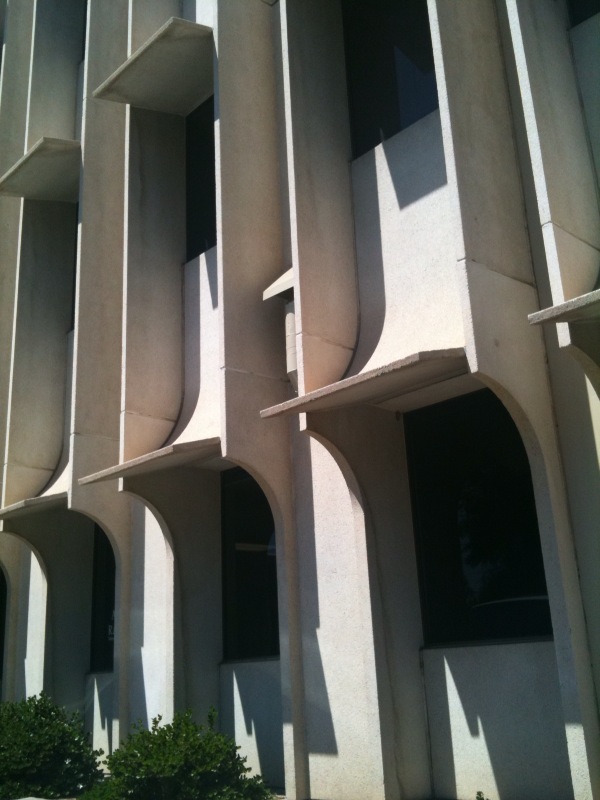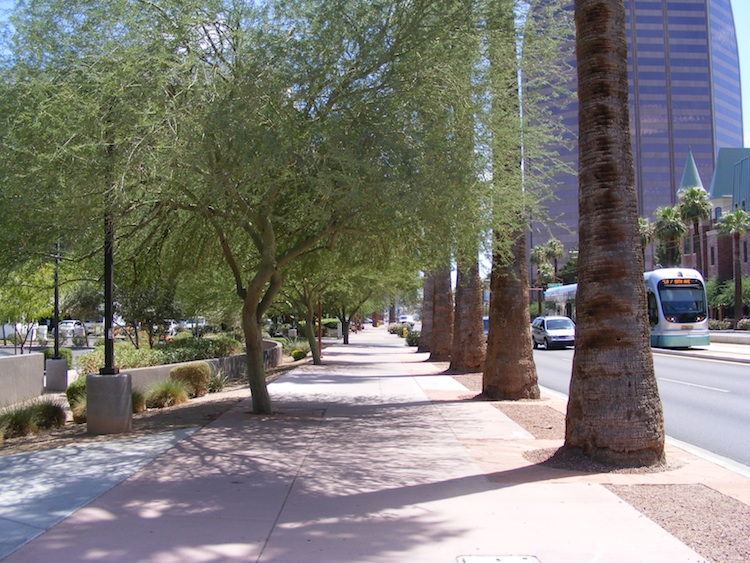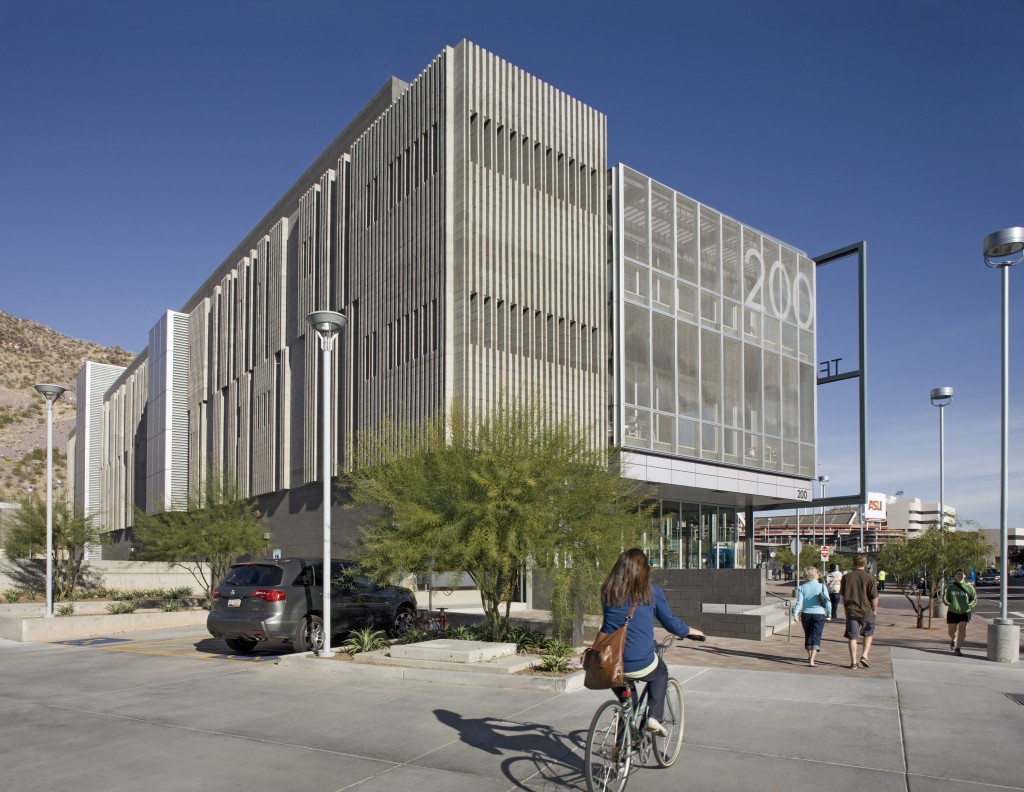Today’s post is by Mick Dalrymple giving us multiple, holistic strategies to protect ourselves and our buildings from the upcoming summer heat!
Mick Dalrymple, MIM, MBA, LEED AP BD+C and HOMES, BPI is the ASU project manager for Energize Phoenix, a $25MM federally-funded program to upgrade the downtown Phoenix core for significant energy efficiency savings.
Dalrymple launched into the green building and sustainability movement in 2001 as a pro-active response to U.S. national security and energy supply issues. He co-founded the Arizona Chapter of the US Green Building Council and recently completed two terms on the national board.
His diverse past includes co-founding a.k.a. Green Environmental Building Supplies and a.k.a. Green Services, creating a green building television series that PBS sought to air nationwide, helping write ICC-700 the National Green Building Standard, and remodeling his own home to achieve a 75% energy use reduction.
Dalrymple, a produced feature film screenwriter, is a graduate of the Thunderbird School of Global Management and Arizona State University’s MBA program, and studied Electrical Engineering, Math and International Relations at the University of Arizona, graduating with High Distinction. The Business Journal of Phoenix named him Green Pioneer in 2009 and AZ Magazine named him one of the Valley’s “most intriguing” people.
Shade trees in Downtown Phoenix. Photo by Taz Loomans.
The season is nearing when Valley dwellers begin to look for the parking space under the tree rather than the closest parking space to their destination. This is the time we most closely mimic the habits of our native animal neighbors: Seek shade, stay inside, search for water and moisture, venture out in the early mornings while it is light but still bearable. Seems like common sense, like the parking space strategy. So why not apply that to our structures, as well?
Shade is usually associated with blocked or filtered light, but it is rarely the visible light with which we are really concerned. It is the accompanying radiant heat. Light good. Summer heat bad. If we alter our definition of shade to the idea of eliminating or deflecting radiant heat, we broaden our portfolio of strategies to live within our climate and still clutch onto that prized ideal of visible, nourishing daylight. Those strategies include: orientation, vertical shading, horizontal or canopy shading, high-performance glazing, reflective roofing, hardscape minimization, and microclimates, among others.
Orientation is the most elemental and most undervalued form of radiant shade maximization. Our homes and buildings should be built with the lengths facing north and south. Garages or other least-occupied space should be situated on the west end of the home to shade the conditioned, occupied structure from the late afternoon heat. Main entry is best from the north. The majority of window space should also be focused on the north. Unfortunately, developers and builders often ignore these basics because of the inconvenience and cost it places on maximizing the number of lots in a development, much to the detriment of the homeowner’s comfort and utility bills. Orientation optimization can also present creative challenges when trying to capitalize on certain views.
Vertical shading is important for east and, especially, west windows and walls. Shading can take the form of trees, high shrubs, trellised walls, perforated metal screens, shade screens, landscape walls, mounded earth, exterior window security blinds, sheds, common walls (such as in townhomes or condos), ceramic radiant barrier paint, light colored paint or building materials and anything else that creative architects and homeowners can design to block or reflect heat. The Tempe Transportation Center even uses a creative application of masonry “H”-shaped blocks such that they shade themselves in a sort of heat-sink design. On another note, while interior blinds do provide some relief, they suffer from a losing battle in that they fight heat that has already made it into the building.
The H-shaped blocks at the Tempe Transportation Center. Photo courtesy of Architekton.
Horizontal or canopy shading is almost universally beneficial. Use some of it on the north side via overhangs to keep the heat off of the walls and windows. On the south side, overhangs should be designed to keep the sun off the walls and windows in the summer but allow the sun to angle in and heat them in the winter. (The question, with our rising temperatures, is whether you design for shade through September or through October!) An excellent tool for sizing and placing horizontal overhangs for windows is at www.susdesign.com. High or clerestory windows underneath overhangs are a great way to get daylight into a space with reduced direct radiant heat. And shading the roof provides the same thermal benefit as parking under the tree in the parking lot.
A horizontal shading strategy on a mid-century modern office building west of Central Avenue on Osborn Rd. Photo by Taz Loomans.
Continual technological improvements give us greater design freedom to get light in and views with less heat gain through the availability of high-performance glazing. Windows are the weakest link in the building thermal envelope, but they are getting better. Until recently, Low-e2 was the performance benchmark. Milgard’s SunCoatMax reduces solar heat gain by an additional 34% over low-e2 while only cutting visible light by an additional 7%. With a net 65% visible light transmittance, your eyes have an easier time adjusting between outdoor and indoor views, enhancing the indoor/outdoor living we strive for in the Southwest. Other manufacturers have come out with similar technologies, while SageGlass is actually controllable and can dramatically reduce solar heat gain (and visible light) in its darkened state. Other options allow daylight without views, such as tubular skylights (Velux and Solatube) and Kalwall daylighting panels (geared for commercial applications).
By looking at shade with the altered goal of blocking radiant heat, it is clear that reflective roofing serves as a strong strategic ally. Roofs, after all, receive the brunt of the annual summer assault. Energy Star certified roofing products or high-scoring Cool Roof Rating Council products reflect the radiant heat back off of the building, dramatically reducing the workload of attic insulation and effectively “shading” the home. The temperature difference between a white roof and a black roof on a 75 degree day can be 50 degrees or more. Cool roofs do not all need to be white, either. Spectrally-selective metal roofing comes in a variety of colors. And a “green” or vegetative roof will also block heat from ever reaching the indoor space.
Hardscape minimization reduces your personal heat island effect, shading your home or building from heat before and after the sun goes down. Hardscape both reflects heat onto the house and stores heat. It is the hot that just keeps giving, long after the sun goes down. Even with overhangs, a concrete slab on the south side of a building will bounce heat towards windows and walls, creating an oven effect. Improvements include plants, ground cover, finely decomposed granite (rather than rock landscaping), mulched landscaping, permeable concrete (vs. solid slab), materials that don’t readily adsorb heat, planters buffering the hardscape from the home, canopy-shaded hardscape, and thermally-broken hardscape (such as pavers with soil joints between them). We have an unexplainable fascination in our region with the blanket of rock for groundcover. Somehow, it became associated with xeriscaping. However, I can’t recall the last time I found any systematic rock groundcover in the native desert. It makes no natural or thermal sense to surround our buildings with it.
An beautiful example of thermally-broken hardscape found at architect Marlene Imirzian‘s office in Sunnyslope. Photo by Taz Loomans.
Microclimates create many benefits in shading against summer heat. One of the most common examples is at entryways. Entryways should be protected with shade, but they can also be framed with vegetation, the greener vegetation being located closer to the entrance. The combination of shade and plant evaporative cooling creates a thermal decompression zone near the entryway. This results in less energy loss when doors are opened and also allows our bodies to adjust a bit more smoothly from the harsh outdoor climate to the conditioned indoor climate. A similar concept applies to the entire landscaping scheme. Xeriscape zones should be located further from the building and any grass or water features (used sparingly) located next to the home, providing for both cooling of the building for outdoor living spaces during transitional seasons.
As the season turns from “where did our Spring go?” to hot to hotter, keeping shade strategies in mind and remembering that it is invisible, radiant heat that is the target will get us through. Applying these strategies on a larger scale will also help the Valley combat the urban heat island effect and provide some relief to us all.
© 2011 Desert Moon Productions, Inc.






















Great piece, I agree that the sea of rocks/gravel thats so associated with xeriscaping is pretty awful.
One question, if one were to have a cool/reflective roof would that potentially make having a solar hot water heater difficult? Solar hot water heaters work by the actual heat on the roof not the light of the sun so if one’s roof is dramatically cooler I wonder if it would make Solar hot water heaters less effective.
Will – Excellent question. I do not have scientific data on this, but here is my hypothesis:
1) The solar water heater is actually mostly absorbing ultra-violet and infrared heat directly from the sun through the front side of the panel.
2) The cool roof is reflecting the same off of itself, some of which is heating up the underside of the panel.
3) When the sun goes down, a cool roof will not continue heating the backside, though a dark roof or tile roof will continue radiating for awhile.
I have a solar water heater on my cool roof and have no problems getting more than enough hot water through much of the year. In fact, the panel is tilted further south to maximize winter sun because that is when it is needed most. In the summer, it gets more than it needs for our needs.
Thanks. Your comment reminded me to turn off the breaker for the back-up heating element, as I don’t expect to need it again until next October or November. And you bring up the excellent point about unintended consequences of any improvements (which I inadvertantly left out of the article). Remember that if a shade mechanism is reflecting off heat in the summer, it is also doing so in the winter when you might want it. There are some shading strategies that work around this (deciduous trees, louvered systems, rolling or removable screens), but not all work for all occasions.
[…] picture when we think of sustainable desert landscaping. As Mick Dalrymple has pointed out on his guest post for the Blooming Rock blog, “we have an unexplainable fascination in our region with the […]